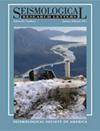2022 年新西兰国家地震灾害模型中基于特征的震级-频率分布与基于古腾堡-里克特震级的震级-频率分布的比较
IF 3.2
3区 地球科学
Q2 GEOCHEMISTRY & GEOPHYSICS
引用次数: 0
摘要
地震灾害概率分析需要一个地震率模型,或者换句话说,需要对地震率进行预测。在新西兰国家地震危险模型 2022 中,地震率模型是通过对绘制的断层上的地震和分布在空间网格单元上的地震进行独立预测而构建的。在此,我们探讨了上板块(下心≥ 40 千米)事件的地震率模型,以研究考虑到在单个断层带内成核(或下心位于其中)的事件的震级-频率分布(MFDs)形状。我们发现,80%以上的断层带的震级频率分布更适合用古登堡-里克特分布(GR)来描述,而不是特征分布(即较大震级发生率远高于古登堡-里克特分布趋势)。此外,MFD 分类既不受时间相关(和时间无关)因素的影响,也不直接受断层带大小(或面积)的影响。滑动速率较快(>20 毫米/年)的断层带表现出特征性的多断层破裂,而滑动速率较慢的断层带可能会也可能不会表现出特征性的多断层破裂。虽然多断层破裂在特征分布中很普遍,但大的最大震级(Mw >8.0)在产生特征性多断层破裂中起着关键作用。另一方面,在 GR 分布中观察到的大多是物理上不相连的多断层破裂(即涉及跃变≥ 10 km 的破裂)。本文章由计算机程序翻译,如有差异,请以英文原文为准。
Characteristic versus Gutenberg–Richter Nucleation-Based Magnitude–Frequency Distributions in the New Zealand National Seismic Hazard Model 2022
Probabilistic seismic hazard analysis requires a seismicity rate model, or in other words, a forecast of earthquake rates. In the New Zealand National Seismic Hazard Model 2022, the seismicity rate model is constructed through independent forecasts of earthquakes on mapped faults and earthquakes distributed over cells in a spatial grid. Here, we explore the seismicity rate model for upper plate (hypocenter ≥ 40 km) events, to investigate the shape of magnitude–frequency distributions (MFDs) considering events nucleating (or for which the hypocenters are located) within individual fault zone. We find that more than 80% of the fault zones have MFDs that are better described by a Gutenberg–Richter (GR) distribution, instead of a characteristic distribution (i.e., rates of larger magnitudes much higher than the GR trend). Furthermore, the MFD classifications are neither influenced by time-dependent (and time-independent) considerations nor directly affected by the size (or area) of the fault zones. Fault zones with faster slip rates (>20 mm/yr) exhibit characteristic MFDs, whereas those with slower slip rates may or may not. Although multifault ruptures are prevalent in the characteristic distributions, large maximum magnitude (Mw >8.0) plays a pivotal role producing a characteristic MFD. On the other hand, physically unconnected multifault ruptures (i.e., involving rupture jumps ≥ 10 km) are mostly observed with GR distributions.
求助全文
通过发布文献求助,成功后即可免费获取论文全文。
去求助
来源期刊

Seismological Research Letters
地学-地球化学与地球物理
CiteScore
6.60
自引率
12.10%
发文量
239
审稿时长
3 months
期刊介绍:
Information not localized
 求助内容:
求助内容: 应助结果提醒方式:
应助结果提醒方式:


